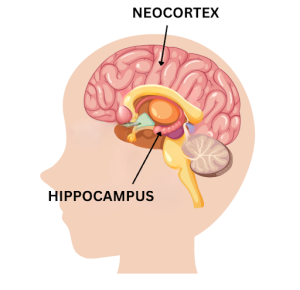Hitting Snooze on Memory Loss
By Elizabeth Carroll, C2ST Intern, Loyola University
While cramming for your last exam of finals week, you’re struck with a thought all too common in these desperate times: if only I could absorb my notes while I sleep! As it turns out, this may be more feasible than you think. Using a method called Targeted Memory Reactivation (TMR), you can strengthen specific memories as you sleep. From improving motor skills to altering emotions, this method provides a plethora of potential applications that can support our mental and physical longevity.

To understand TMR, we first need to understand the crucial role of sleep in our ability to create long-term memories. We establish long-term memories in a process called memory consolidation, which happens most efficiently when we are in our deepest stage of sleep. During this stage, known as “slow wave sleep” (SWS), the brain cells that store short-term memories are reactivated in the hippocampus. The hippocampus is often referred to as our brain’s flash drive because it efficiently packages our memories, allowing us to learn and retain information. Memories reactivated in the hippocampus are replayed to the neocortex, the part of the brain that strengthens and solidifies them into long-term memories. After gathering this knowledge, researchers began to wonder whether we could strengthen particular memories by selectively triggering these memories during SWS. From this curiosity, the concept of Targeted Memory Reactivation (TMR) was born.

TMR is performed by triggering specific memories using auditory cues associated with these memories during SWS, generally in a research setting. Pretend you’re a neuroscientist studying the efficacy of TMR on me, your subject. First, I’ll undergo the “learning” stage: I play a spatial memory game which requires me to memorize the locations of pictures on a grid as they appear on the screen. As each picture appears on the grid, a sound is played associated with the picture. Next, you test my ability to place the pictures in their accurate locations on the grid. I go to sleep wearing a monitor that shows you the stage of sleep I am in. Once I enter SWS, you play half of the sounds that were paired with the pictures I saw during the learning stage. When I wake up, I retake the test of placing pictures on the grid.
Now it’s time for you, the neuroscientist, to compare the results of these two memory tests. I placed the pictures on the grid more accurately during the second test, showing that memory consolidation happens while we are asleep. More notably, I was also more accurate with my placement of the pictures associated with the sounds you did play while I was sleeping than those associated with sounds you didn’t play. This was the procedure and result of a 2024 study performed in Ann Arbor, MI. Researchers concluded that hearing audio, which we associate with certain memories during SWS, can selectively reactivate and strengthen these memories.
From the outcome of this study, we now understand how visual and spatial memories can be enhanced using TMR. These fit into the category of long-term memory called declarative memory. Our declarative memories encompass all of the facts and events we consciously remember, like our friends’ birthdays or what we had for dinner last night. The other category of long-term memory is called procedural memory. These are the “how-to” instructions that allow us to subconsciously execute skills we have learned through repeated practice, like riding a bike or tying our shoes. Researching the effects of TMR on procedural memories is slightly more difficult than declarative memories because it often involves testing motor skills, which recruit several different areas of the brain when they are initially learned versus when they are subconsciously executed. One study found that TMR gradually improved motor skills in subjects over the course of 10 days, but these skills were lost again over the next two months.
TMR has been studied and widely accepted by neuroscientists as a promising method to strengthen memories. With recent progress in mental health and trauma-related research, scientists are beginning to question whether TMR can modify the emotions we feel surrounding certain declarative memories. Preliminary research in this field suggests that TMR can be used to update unpleasant memories to evoke neutral or positive emotions and even be harnessed as a tool to forget information. Traumatic events trigger the fight or flight response as a survival mechanism that has evolved to protect us from imminent threats, but this response is only supposed to be active temporarily. If the brain is in fight or flight for too long following trauma, the body is stuck on high alert and struggles to regulate its typical functions. Gastrointestinal disorders, reduced capacity of the immune system, and pain disorders are some of the physical health issues that are associated with trauma, in addition to long-term psychological disorders. With TMR, there is hope to prevent these devastating conditions by reversing the immediate emotional effects of trauma.
There are many questions we still have about TMR. Can it be used to retrieve memories we believe to be completely lost? Is it ethical to use TMR for memory modification or purposefully forgetting events? How does it impact our dreams and other aspects of our sleep?
And as for that last-minute sleepy study session — TMR may not promise an A+, but it could be worth a shot!
Resources
- https://www.ncbi.nlm.nih.gov/books/NBK482171/
- https://www.psychologytoday.com/us/blog/in-the-body/201910/when-trauma-gets-stuck-in-the-body
- https://journals.sagepub.com/doi/full/10.1177/1078390311425187?casa_token=NDU4gZBX3toAAAAA%3AdUT917qwQGqRbOyxMX-bJ0NQ0GsS8x6oytpYx43mAVLoYd2RVR14TJTyaUfz-2QYjjjOYdq9oqlQ
- https://www.nature.com/articles/s41539-024-00244-8
- https://journals.physiology.org/doi/epdf/10.1152/advan.00056.2024